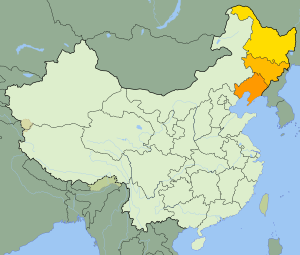Jehol Biota facts for kids
The Jehol Biota was an amazing ancient ecosystem that existed in northeastern China. It was home to many different living things, like plants, insects, fish, and even feathered dinosaurs! This special time was between 133 and 120 million years ago, during the Lower Cretaceous period.
Scientists have found many fossils from the Jehol Biota in rock layers called the Yixian Formation and Jiufotang Formation. These layers are made of volcanic ash and other sediments. The area was mostly wetlands and lakes, not big rivers or oceans. The weather was temperate, meaning it wasn't too hot or too cold. Rainfall changed with the seasons. Sometimes, volcanoes nearby would erupt, covering the land with ash. The name "Jehol" comes from an old name for a province in China.
Contents
When Did the Jehol Biota Begin?
Scientists have different ideas about when the Jehol Biota truly started. Some think it slowly grew from an older ecosystem called the Daohugou Biota. However, special dating methods show that the Daohugou Biota was much older, from the Middle to Late Jurassic period (about 164 to 158 million years ago).
To help identify the Jehol Biota, scientists often look for certain index fossils. These are specific types of fish, like Peipiaosteus and Lycoptera. When these fish fossils are found, it's a good sign that the rocks belong to the Jehol Biota. The very first part of the Jehol Biota is found in the Huajiying Formation.
Amazing Fossil Preservation
The Yixian and Jiufotang Formations are famous for their incredibly well-preserved fossils. Places like this are called Lagerstätte, which means they have excellent conditions for fossils to form. Not only are there many fossils, but they are also very detailed. Scientists have found complete skeletons, soft body parts, color patterns, and even what animals had eaten! Twigs with leaves and flowers still attached have also been discovered.
Scientists believe two main things helped with this amazing preservation:
- Animals and plants were gently washed into the lakes, or they died in the lakes. Their bodies weren't damaged by strong floods.
- Volcanic ash often fell into the lakes. This ash quickly buried the dead organisms. This created conditions with very little oxygen (called anoxic conditions). This stopped other animals from eating the bodies and helped them turn into fossils.
A Special Place for Life
The Jehol Biota was a unique place during the Early Cretaceous period. It had a mix of very old species and new, more advanced ones. Some species were only found in Jehol, while others were found all over the world. It's possible that northeastern Asia was separated from other parts of the world for a while during the Jurassic period by a sea called the Turgai Sea.
Many species found in Jehol were thought to have died out much earlier. These "relict" species include the small dinosaur Sinosauropteryx and the pterosaur Dendrorhynchoides. But the Jehol Biota also had the earliest known members of groups that later spread across the globe. These include neoceratopsians (like Psittacosaurus), therizinosaurs, tyrannosaurs, and oviraptorids. This suggests that northeastern Asia might have been a "birthplace" for these dinosaur groups.
However, the Jehol Biota wasn't completely isolated. It also had animals found worldwide at the same time. These include certain frogs, lizards, mammals, birds, other pterosaurs, and large plant-eating dinosaurs like iguanodontians and titanosauriform sauropods.
Amazing Diversity of Life
The Jehol Biota is famous for having a huge variety of different species. Scientists have found many fossils of each type of animal and plant.
The fossils include tiny plant parts, early angiosperms (flowering plants), snails, clams, many small water creatures called conchostracans and ostracods, shrimps, insects, spiders, fish, frogs, salamanders, turtles, choristoderes (lizard-like reptiles), pterosaurs, and many kinds of dinosaurs, including feathered dinosaurs. It also has some of the largest mammals known from the Mesozoic Era, and a great variety of birds, including some of the earliest advanced birds.
The forests around the lakes were mostly made up of conifer trees, like modern-day pines and cypresses. There were also ginkgos, horsetails, ferns, and mosses. The leaves of the trees show they were adapted to dry seasons. However, some ferns and mosses usually grow in very wet places. They might have survived the dry times by growing very close to the water. A plant called Archaefructus is thought to be one of the earliest known flowering plants, and it probably grew in the water.
Here are some examples of the many species found in the Jehol Biota:
- Snails (Gastropods): Bellamya clavilithiformis, B. fengtienensis, Probaicalia gerassimovi
- Clams (Bivalves): Arguniella cf. ventricosa, Nakamuranaia
- Water Arthropods (Conchostracans): Eosestheria, Diestheria, Liaoningestheria
- Insects: Ephemeropsis trisetalis (a mayfly), Mesolygaeus laiyangensis
- Fish: Lycoptera spp., Peipiaosteus, Sinamia
- Reptiles: Monjurosuchus splendens (a choristodere), Yabeinosaurus tenuis (a lizard), Psittacosaurus (a dinosaur)
- Mammals: Endotherium niinomi, Origolestes lii
How the Jehol Biota Was Studied
The name "Jehol Biota" was first used by scientists in 1959 and officially published in 1962. Before that, it was sometimes called the "Jehol Fauna." An early scientist named Amadeus William Grabau described it as a group of fossils that included many Eosestheria (a small water creature), Ephemeropsis (a mayfly), and Lycoptera (a fish). Because of these three, it was sometimes called "EEL."
Scientists have studied the different rock layers that make up the Jehol Biota. These layers include the Yixian Formation and the Jiufotang Formation. More recently, scientists have suggested that the boundaries of the Jehol Biota should be based on the large volcanic eruptions that created the rock layers. They also confirmed that the fish Peipiaosteus and Lycoptera are the best fossils to identify the Jehol Biota. Under this idea, the earliest part of the Jehol Biota is found in the Huajiying Formation.
See also
 In Spanish: Biota de Jehol para niños
In Spanish: Biota de Jehol para niños
- Daohugou Biota
- Jiufotang Formation
- Yixian Formation
- Paleobiota of the Yixian Formation


